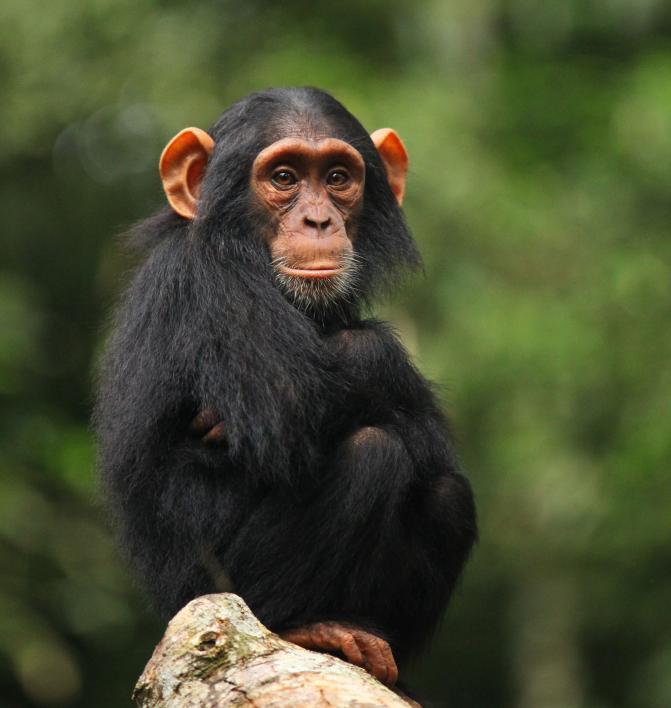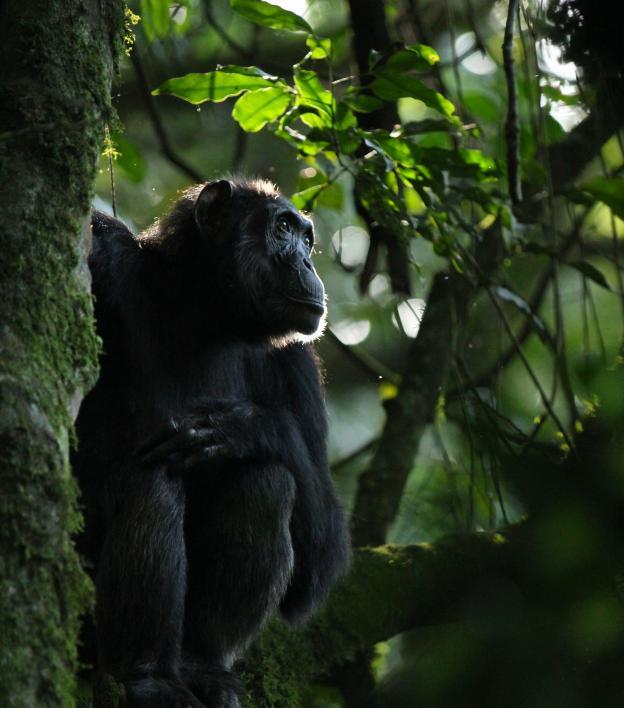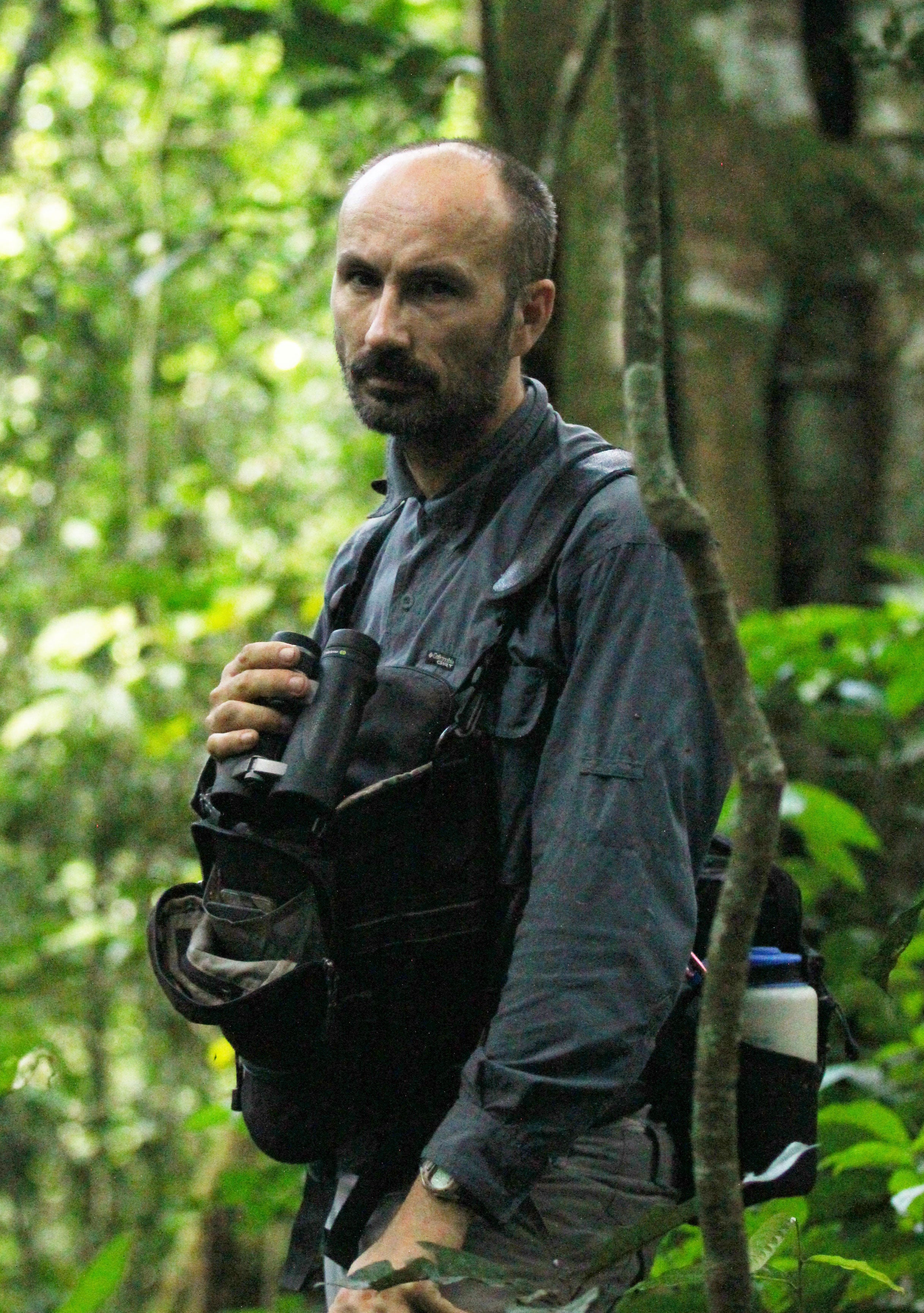Kevin Langergraber has been studying chimpanzees in the wild for 15 years.
Before he became a professor and had to teach eight months out of the year, he’d spend six months to a year at a time in the field, 12 hours a day, seven days a week.
“The most surprising thing about the job is that you can still be surprised by the job,” said Langergraber, a primatologist and assistant professor in the School of Human Evolution and Social ChangeThe School of Human Evolution and Social Change is a unit of the College of Liberal Arts and Sciences. at Arizona State University.
“After a while you’d think, ‘OK — I’ve spent thousands of hours watching these guys. What is going to surprise me when I wake up and spend my 12-hour day in the forest?’ ” he said. “Despite all this time I’m still shocked when I go back and the chimps show me something I hadn’t seen before.”
Langergraber, who has been at ASU for a year and a half, co-directs the Ngogo Chimpanzee Project in Kibale National Park, Uganda, home to the largest wild chimp community in the world. About 200 individuals live in the 35-square-kilometer preserve in the middle of the 800-square-kilometer national park. The community has been studied since 1995.

Django, an adult male chimp in the Ngogo Chimpanzee Project in Kibale National Park, Uganda. Top: Penelope, an adult chimp, with her female infant, Kozena.
Photos by Kevin Langergraber
One big surprise came last summer. In the beginning of the season, food was lean. When food supplies are down, chimps are hard to find because they split into tiny groups to forage. But food availability crept up, to the point where three of their favorite fruits ripened at the same time.
“They basically had more food than they knew what to do with at this point,” Langergraber said. “It was falling off the trees and sitting on the ground uneaten.”
About 30 adult females with 60 kids congregated. “There were these huge parties, these huge hordes of chimpanzees, which was very unusual, especially for females, which are more solitary than male chimpanzees,” he said. “They began exhibiting really male-like behavior.”
Chimps hunt monkeys, but it’s almost always done by males, in groups. Females do hunt, but much less than males.
“(The females) started going on this little mini-hunting binge, where they were hunting almost every day over the course of a few weeks,” Langergraber said. “That is something I’d never expected to see in my life. … I’ve been there for 15 years, and this is something out of the blue I think will be important for learning about why in general is it males hunt more than females and questions like that.”
Chimpanzees are classified as endangered by the International Union for the Conservation of Nature. They’re endangered throughout their range across equatorial Africa. The IUCN estimates there are less than 300,000 chimps in the wild, according to a rough estimate made in 2003. Those numbers are expected to drop.
“Due to high levels of exploitation, loss of habitat and habitat quality due to expanding human activities, this species is estimated to have experienced a significant population reduction in the past 20 to 30 years, and it is suspected that this reduction will continue for the next 30 to 40 years,” the IUCN Red List said on its website.
“Kibale National Park is probably the last stronghold of chimpanzees in the country of Uganda,” Langergraber said. “We don’t know how exactly how many chimps are there.”
Chimpanzees are hard to count. They live in communities with permanent members, but it’s like a university — you never see the whole community in one place at one time. Chimps make nests every night to sleep in. Counting the nests has been the way the population size is estimated — anywhere from 800 to 1,000 in Kibale.
“We know these nest surveys aren’t terribly accurate,” Langergraber said. “One of the things I’m doing in my research is to really find out how many chimpanzees are in Kibale National Park. We’re doing that through a genetic census.”
Park anti-poaching patrols pick up chimp feces on their patrols. Langergraber does genetic analyses of the samples.
“Then you get a genetic fingerprint for that individual,” he said. “We’re doing this over time. It’s a long-term process. We’ve been doing it for a couple of years now. Based on how many times you’re collecting the same individual over again, versus an entirely new individual you haven’t seen before, you can get an estimate of the population size.”
It’s much more accurate than counting nests.
“Our preliminary results suggests there may be twice as many chimpanzees living in Kibale National Park as we previously thought,” he said. “They’re doing well in Kibale, for now.”
Poaching is widespread throughout the whole park. Eating chimpanzee is actually taboo in this part of Uganda, but poachers go after bush pig and duikers — tiny forest antelope — and chimps become caught in the snares. “They’ll spear it and feed it to their hunting dogs,” Langergraber said. “Poaching has increased, especially for larger game, like elephants.”
The research presence in Ngogo wards poachers away from that area of the park. Two three-person snare-removal teams — ex-poachers lured from the life with good stable jobs — patrol Ngogo in conjunction with local wildlife-authority officers.
“Our guys work with the (Uganda Wildlife Authority) rangers, who have guns, which really helps to protect the park,” said Langergraber (pictured left). The project hopes to hire a third team for patrols.
Research with chimpanzees is long-term. Chimps are long-lived and slow-producing — one infant every five years.
“That makes them very difficult to study,” Langergraber said. “Just now chimpanzee researchers have been out there long enough to really document the whole lifespans of chimpanzees. In particular one of the things we’re interested in in evolutionary biology is what determines which individuals are reproductively successful. ... Things like that are important stuff that’s coming up now and in the future.”
There are multiple chimps at Ngogo more than 60 years old, including one very rare great-grandmother.
“We’ve got a bunch of old ladies running around the forest there,” Langergraber said. “It’s a good place to be a chimp, Ngogo.”
More Environment and sustainability

Charles Redman, founder of the School of Sustainability, faces a new adventure: Retirement
At the retirement celebration for Charles Redman on Oct. 22, two messages persisted: Redman’s contributions to Arizona State University helped to shape the interdisciplinary efforts we now find…

10 climate insights to guide our future
A group of globally renowned social, natural and climate scientists has once again convened to offer their newest annual synthesis report, “10 New Insights in Climate Science.”The report, published…

The future is green: Job demand translates to high employability for ASU sustainability grads
A 2023 report by Forbes on the state of green jobs confirmed what Arizona State University has been trumpeting for years: Sustainability will play a large part in the new economy.The report suggests…










